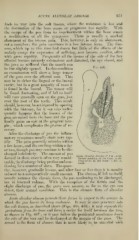Page 921 - My FlipBook
P. 921
ACUTE ALVEOLAR ABSCESS. 931
finds its way into the soft tissues, where the resistance is less and
the destruction of the bone ceases or progresses less rapidly. With
the escape of the pus from its imprisonment within the bone comes
a modification of all the symptoms. There is usually a marked
abatement of the intense pain. This, however, is only an abatement,
not a cessation : the pain continues in a less intense form. The feat-
ures, which up to this time had shown but little of the effects of the
malady except the expression of suffering, now become swollen, often
with great rapidity. Frequently all the tissues of the side of the face
affected become intensely oedematous and distorted, the eye closed, and
the jaws so stiffened that the mouth can
Fig. 486.
be but slightly opened. In this condition
an examination will show a large tumor
of the gum over the affected root. This
may be in either the lingual or the buccal
cavity, but in a great majority of cases it
is found in the buccal. The tumor will
be found fluctuating, aud if left to itself
will very generally open on the gum, just
over the root of the tooth. This result
should, however, be anticipated by opening
with the bistoury, for it not very unfre-
quently happens that the tissues of the
gum are raised from the bone and the pus
finally gains an exit at the gingival mar-
gin ; which complicates the process of re-
covery.
After the discharge of pus the inflam-
matory symptoms usually abate very rap-
idly. The pain generally subsides within
a few hours, and the swelling within a day
or two, though pus may continue to be dis-
charged indefinitely. The amount of pus
Acute Alveolar Abscess of the Lower
formed in these cases is often very consid- Incisor poiuting on the Gum: a, ab-
scess-cavity in the bone ; c, lip ; d,
erable, the discharge being profuse and con-
tooth.
tinuing for a number of days. The quan-
tity, however, gradually lessens, and after four or five days it is usually
reduced to a comparatively small amount. The abscess, if left to itself,
usually assumes the chronic form, the pus continuing to be discharged,
but in lessened volume. With the exception of the fistula and the
slight discharge of pus, the parts now assume, so far as the eye can
detect, their normal condition. This is the chronic form of alveolar
abscess.
Acute alveolar abscess presents three forms in respect to the manner in
ichich the pus leaves its bony enclosure. It may at once penetrate into
the soft tissues, as described above (Figs. 485, 486) ; it may separate the
periosteum from the bone and form a cavity for itself between the two,
as shown in Fig. 487 ; or it may follow the peridental membrane down
the side of the root and be discharged at the margin of the gum. The
second is the form of abscess that is most likelv to be attended with


